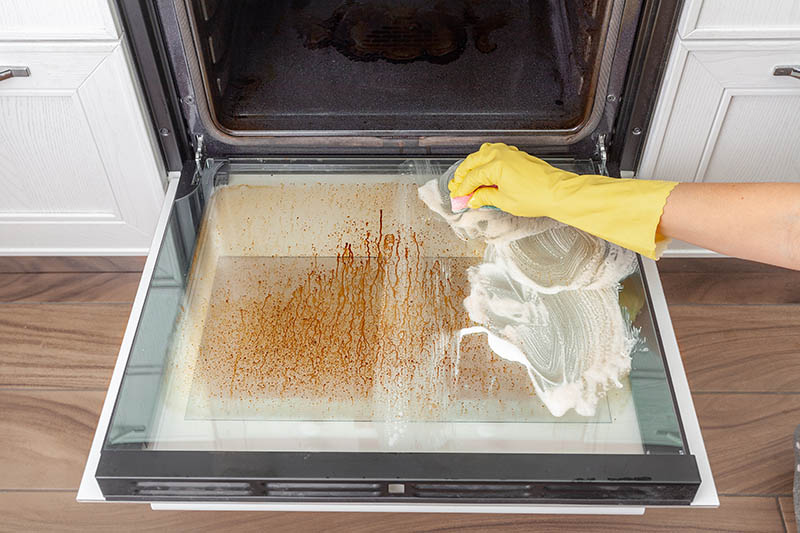Is a Self-Cleaning Oven Safe? Risks, Facts, & FAQ
-
Codee Chessher
- Last updated:

The self-cleaning setting on ovens is one of the most controversial appliance settings of all time. Many people swear by it, some claim it broke their oven, and others fear it’ll poison your home.
While self-cleaning your oven is perfectly safe, it does produce carbon monoxide, and perhaps other hazardous chemicals. It’s unclear how toxic the white smoke is, but most agree that you shouldn’t hang out in the kitchen during the 4–6-hour cycle.
How Does Oven Self-Cleaning Work?
Self-cleaning is a 4–6 hour cycle that raises the oven’s temperature to between 800–1,000 degrees Fahrenheit. The idea is that any crumbs, food residue, oil, or other grime gets totally incinerated by the oven’s intense heat. The results are undeniable, and self-cleaning merely leaves a layer of fine white ash that you can wipe off with a wet rag.

Does Self-Cleaning Damage the Oven?
The internet is full of horror stories from users who claim using the self-cleaning setting on their oven broke it. Unfortunately, there’s little formal research on the topic, but people speculate the cycle may have overworked the heating element or one of the electrical components within the machine.
We can’t know for sure without further study, but there’s a small chance that using the self-cleaning feature on your oven will cause it to prematurely fail. Then again, many people claim that they use the cycle regularly without any problems. So, it’s up to you to determine if you want to take the risk.
Risks of Self-Cleaning
The three main risks of using the self-cleaning cycle are fire hazards, carbon monoxide poisoning, and the risk of burning. Let’s cover those in a bit more detail below.

Fire Hazard
Self-cleaning cranks the temperature up to 1,000 degrees Fahrenheit, so anything in the oven will burn. Large chunks of food, oil, liquids, and other residue or gunk can burst into flame and pose a fire risk, though such fires are typically rare and short-lived.
Carbon Monoxide Poisoning
Carbon monoxide (CO) is a colorless, odorless, and tasteless gas produced during combustion. Produced by propane and gasoline-powered equipment, carbon monoxide is also produced by an oven’s self-cleaning cycle.
Carbon monoxide is so dangerous because it suffocates you by physically displacing the oxygen in your body. Poisoning symptoms are commonly mistaken for other health problems, which is why detectors are essential in all households.
Burn Hazard
Self-cleaning makes your oven extremely hot, and you won’t be able to safely touch the oven at all when it’s running the cycle or cooling down afterward. This means the self-cleaning cycle can be a serious burn hazard for curious pets and children. We urge you to keep any kids or pets in a different room than the kitchen or outdoors if you want to be safe.

How to Use Self-Cleaning Safely
Self-cleaning might seem like a dicey proposition, but most people experience no ill effects or mechanical problems when using it. As long as you observe a few common-sense precautions, you may find that you can never go back to manually cleaning the oven or using messy oven-cleaning spray. Let’s check out how to use the self-cleaning cycle on your oven.
- Open the oven and manually remove any large chunks of food since these can pose a serious fire risk.
- Wipe up any major oil, sauce, or liquid spills in the oven.
- Remove the racks from the oven unless your oven specifically says they’re safe to use during the self-cleaning cycle.
- Open all doors and windows in the kitchen.
- If possible, turn on the range hood fan or run a fan in the area.
- Close the oven door and press the self-cleaning button.
- Wait for the duration of the cleaning cycle, then wipe the remaining residue inside the oven with a damp cloth.
 Conclusion
Conclusion
Self-cleaning can seem like a gimmicky or dangerous feature, but it isn’t especially dangerous if you make sure to ventilate the area, keep pets and kids away, and don’t touch the oven. Information is conflicted about whether self-cleaning can damage your oven or not, so proceed with the idea that it is a possibility!
Featured Image Credit: Denys Niezhientsev, Shutterstock
Contents
